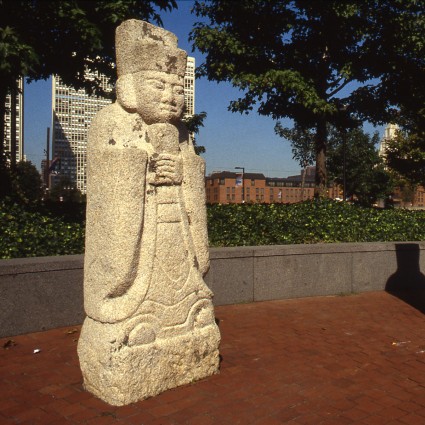At A Glance
This artwork is currently in storage
Spheres was among the sculptures included in an International Sculpture Garden at Penn’s Landing
This sculpture came from a site near Palmar Sur in the delta of Costa Rica’s Disquis River
Pre-Columbian stone spheres have been discovered at sites in Central America, Puerto Rico, and Mexico
Spheres is among several sculptures that were included in an International Sculpture Garden at Penn’s Landing, along the Delaware River between Walnut and Spruce Streets. Due to redesign of the waterfront site, these sculptures are currently in storage in anticipation of the potential relocation of the International Sculpture Garden.
Pre-Columbian stone spheres have been discovered at sites in Central America, Puerto Rico, and Mexico. The largest come from the southern Pacific coast of Costa Rica, where some reach eight feet in diameter and exceed 16 tons in weight while deviating less than a quarter-inch from perfect roundness. To shape such a monolith with primitive tools was a prodigious feat; the stone, moreover, had to be transported by river from outcrops in the mountains. Small spheres were placed in graves; larger ones were set on platforms or arranged in patterns that suggest astronomical alignments. The two spheres at the International Sculpture Garden are from a site near Palmar Sur in the delta of Costa Rica’s Disquis River. The smaller one weighs 9,000 pounds, the larger one almost 24,000. The spheres were brought to Philadelphia with the cooperation of the Costa Rican government.
The International Sculpture Garden
The International Sculpture Garden was conceived by the Fairmount Park Art Association (now the Association for Public Art) in the 1960s as part of the anticipated U.S. Bicentennial celebration. The open-air installation celebrated and demonstrated the impact of other cultures on the American experience, with a focus on ancient and ethnographic artworks. “Each individual piece,” the Association noted, “should not only be typical of that nation’s heritage, but should also be of the highest quality.” The sculpture collection includes a group of significant objects from diverse cultures. The Art Association acquired and installed the garden’s sculpture collection over several years.
Since its 1976 dedication, the garden’s site has undergone many changes. In 1992, Venturi Scott Brown and Associates’ Columbus Monument, a 106-foot-high obelisk, was erected at the north end, and a hotel now also occupies a portion of that section. Conditions surrounding the garden have changed dramatically in recent years, leading to a reconsideration of the existing garden site. In anticipation of the potential relocation of the International Sculpture Garden, most of the sculptures have been removed for conservation treatment and placed in storage.
RESOURCES



